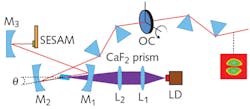
Optical vortices, or laser modes that have angular momentum, creating (for example) a null at the center of the beam, have been used for optical trapping and other purposes. While they are most well-known in their continuous-wave (CW) form, optical vortices can be created using pulses from femtosecond lasers, leading to applications such as subwavelength nonlinear microscopy, femtosecond materials microprocessing, and the creation of laser filaments in air. However, because of the wide spectral bandwidth of a femtosecond laser, it is difficult to produce clean femtosecond optical vortices using the usual phase-based (such as a spiral phase plate) or diffractive optical element, with “clean” meaning a high ring-to-center spatial-intensity contrast.
A group of researchers from Shanghai Jiao Tong University (Shanghai, China), Jiangsu Normal University (Xuzhou, China), Tongji University (Shanghai, China), and Shenzhen University (Shenzhen, China) has completely bypassed the problems created by the use of dispersive optics to create femtosecond optical vortices. The researchers have instead developed a high-order-transverse-mode femtosecond laser that, in combination with a cylindrical-lens mode converter, produces the desired vortex beam. The laser uses a solid semiconductor saturable absorber mirror (SESAM) as a mode-locker, producing a femtosecond Hermite-Gaussian (HG) beam converted by the cylindrical lens into a clean Laguerre-Gaussian (LG) vortex beam. A 793-nm-emitting laser diode (LD) pumps a 9-mm-long, 2-μm-emitting thulium-doped calcium yttrium aluminate (Tm:CYA) mode-locked laser crystal in a noncollinear-pump configuration. The optical train includes a number of lens (L) and mirror (M) elements, calcium fluoride (CaF2) prisms to compensate for group-delay dispersion, and an output coupler (OC). The resulting femtosecond vortex has a ring-to-center intensity contrast of 36 dB, which the researchers say is close to the theoretical limit of an ideal vortex beam. Reference: Z. Qiao et al., Opt. Lett. (2017); https://doi.org/10.1364/ol.42.002547.
About the Author
John Wallace
Senior Technical Editor (1998-2022)
John Wallace was with Laser Focus World for nearly 25 years, retiring in late June 2022. He obtained a bachelor's degree in mechanical engineering and physics at Rutgers University and a master's in optical engineering at the University of Rochester. Before becoming an editor, John worked as an engineer at RCA, Exxon, Eastman Kodak, and GCA Corporation.
